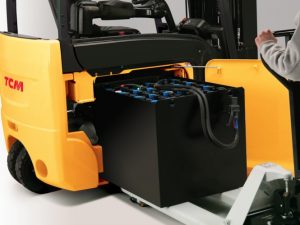Here are some easy maintenance tips that will help you get the most life out of your lead-acid forklift battery.
Lead-acid batteries have a limited life which can be shortened by poor maintenance, incorrect charging, and harsh operating conditions. But with a few easy maintenance tips you can make your battery last as long as it should.
Cleaning The Battery
A forklift battery should be kept as clean as possible. The white stuff you see on the top of forklift batteries is congealed acidic vapor. This congealed vapor is highly corrosive and eats away at the steel case. Without the case intact there is an increased chance of spills and boiling over. The congealed acidic vapor also creates a circuit to the case that slowly discharges the battery and is a potential fire hazard when charging.

The top of the battery can be cleaned a number of ways. You can use a vacuum, a degreaser, water, and an industrial steam cleaner. Keep in mind that congealed battery acid is very corrosive so wear protective gloves, face and eye coverings, and a vinyl apron. The congealed battery acid often turns to dust when disturbed so you should also wear a respirator.
The acid can be neutralized with a mixture of water and baking soda. But be sure the cell caps are tightly sealed so that the base solution doesn’t get into the cells.
A thorough battery cleaning should take place four times per year, or more as needed.
Proper Charging and Equalization Charge
It is best to charge a lead-acid only when the battery is more than 60% discharged – meaning there is 40% remaining charge. But you don’t want to wait until the battery is more than 80% discharged.
Over time your batteries’ cells may develop different charge capacities. Each cell, when new, charges to 2.2 volts, so if you have a 24 volt battery, it’s full charge is actually 26.4 volts. As the battery is discharged and re-charged each cell may have a different reaction and charge more or less than other cells, leading to an undercharged battery.
To prevent unequal cell voltages run an equalization charge once a week. If equipped, your charger will have an equalization button that you press at the beginning of the charge. This charge takes a few hours longer than a typical charge and also requires more cooling time. So keep that in mind when planning shifts.
A lead-acid battery must cool for the same amount of time it took to charge it. For an eight hour charge the battery needs to cool for eight hours before being used.
Watering the Battery
Each forklift battery contains cells and within the cells is a configuration of lead plates and an electrolyte solution. When water is added to the cell it creates an electrolyte, which is a mixture of battery acid and distilled water.
When the cell cap is removed you can look into the cell and see the top of the battery plates. If there is no water above the top plate then water needs to be added. The fluid level should rise about a quarter inch above the top plate.
During normal operation, only add water after the battery has been charged. If you add water before charging, there is a greater risk of the electrolyte solution boiling over and spilling out of the battery during charge.
If your battery needed a lot of water to fill each cell then your acid level will be very low. This means the fluid in the battery is more water than it is acid and has a lower boiling point. If your battery needs a lot of water remember to only add enough to reach the top of the cell. Then after a few charge cycles it will be OK to add more water.
Are you looking to purchase a new forklift battery? You can shop for new lead acid forklift batteries on our website – Forklift Batteries
For more information visit OSHA’s website: Forklift eTool

